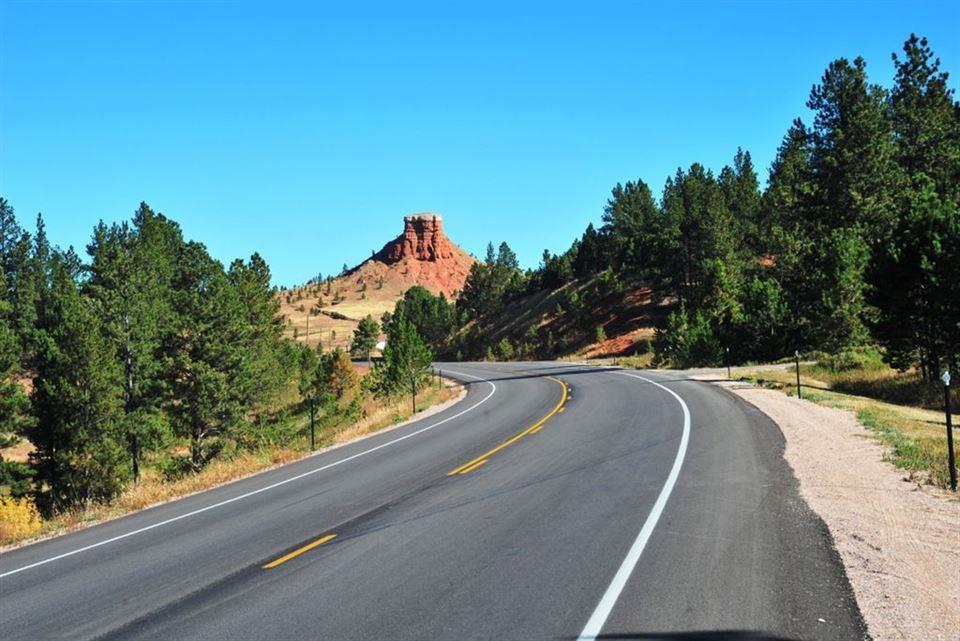Black Hills Scenic Byway
Newcastle | Black to Yellow

The 78-mile Wyoming Black Hills Scenic Byway rests at the western gateway to the sprawling Black Hills area which stretches into South Dakota. Named by Native Americans because the color of tree trunks when it rained, the entire area offers numerous historic sites and cultural resources in conjunction with beautiful natural vistas, unique geology and recreational outlets. While attractions within the South Dakota stretch of the Black Hills, like Mount Rushmore, draw hundreds of thousands each of tourists each year ($562 million in tourism revenue was generated 2009 according to the Black Hills, Badlands & Lakes Association tourism marketing group), Wyoming’s Black Hills remain largely undiscovered. The Wyoming Black Hills’ status as a “hidden treasure” is both a blessing and a curse. On one hand, lack of tourist traffic positions this corridor to the Wyoming Black Hills’ is a great alternative to those truly seeking to step out of the rat race and into nature. On the other hand, communities in our corridor, miss important economic opportunities.
The Black Hills (á Sápa in Lakota, Mohta-vohonáaeva in Cheyenne) are a small, isolated mountain range rising from the Great Plains of North America in western South Dakota and extending into Wyoming. Set off from the main body of the Rocky Mountains, the region is something of a geological anomaly—accurately described as an "island of trees in a sea of grass". Harney Peak, which rises to 7,244 feet (2,208 m), is the range's highest summit. The Black Hills encompass the Black Hills National Forest and are home to the tallest peaks of continental North America east of the Rockies.
The name "Black Hills" is a translation of the Lakota Pahá Sápa. The hills were so-called because of their dark appearance from a distance, as they were covered in trees.
Native Americans have a long history in the Black Hills. After conquering the Cheyenne in 1776, the Lakota took over the territory of the Black Hills, which became central to their culture. When European Americans discovered gold there in 1874, as a result of George Armstrong Custer's Black Hills Expedition, erstwhile miners swept into the area in a gold rush. The US government re-assigned the Lakota, against their wishes, to other reservations in western South Dakota. Unlike most of the area, the Black Hills were settled by European Americans primarily from population centers to the west and south of the region, as miners flocked there from earlier gold boom locations in Colorado and Montana.
The geology of the Black Hills is complex. A Tertiary mountain-building episode is responsible for the uplift and current topography of the Black Hills region. This uplift was marked by volcanic activity in the northern Black Hills. The southern Black Hills are characterized by Precambrian granite, pegmatite, and metamorphic rocks that comprise the core of the entire Black Hills uplift. This core is rimmed by Paleozoic, Mesozoic, and Cenozoic sedimentary rocks. The stratigraphy of the Black Hills is laid out like a target, as it is an oval dome, with rings of different rock types dipping away from the center.
Recreational opportunities abound in the vicinity. Hiking, camping, mountain biking, snowmobiling, fishing and hunting are just a few of the activities enjoyed in the Wyoming Black Hills. Travelers can explore the old ghost towns of Cambria and Tubb Town. Historical sites like the Jenny Stockade, Anna Miller Museum, Black Hills Stage Station and the Harper Grist Mill are all nearby. The Byway is important in that it gives the traveler of today the opportunity to see and understand what it was like for those who lived and traveled in this area 150 years ago. Much of the country hasn’t changed since then and it’s not hard for one to imagine what it was like for the pioneers and Native peoples to see this country for the first time. We cannot understand and appreciate who we are and what we have become if we do not appreciate the lives of those who have gone before and made this country into what it is today.
Learn more about Black to Yellow
Much More to Explore
There are many ways to get out and explore all that Wyoming has to offer. Explore things to do and places to go and make your Wyoming vacation one to remember forever.